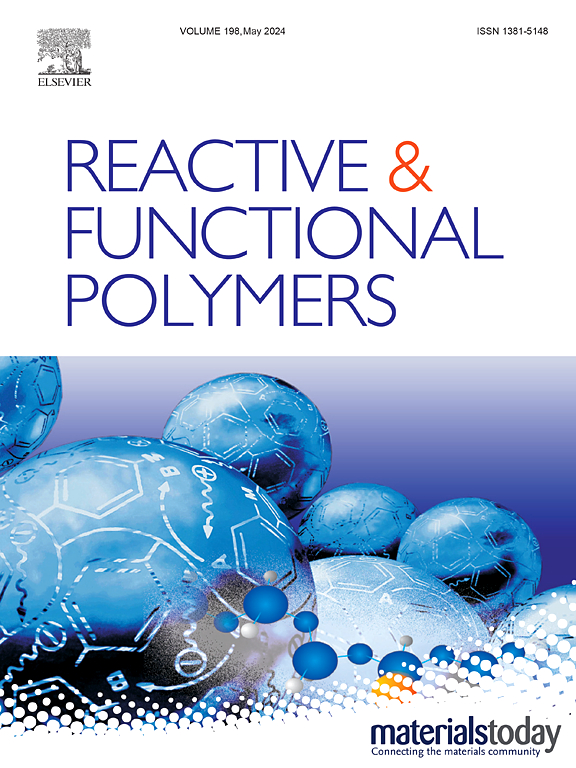香兰素基BDBEP提高了三功能型NNDG环氧树脂的综合性能
IF 4.5
3区 工程技术
Q1 CHEMISTRY, APPLIED
引用次数: 0
摘要
由于对三官能团N-二缩水甘油酯-4-缩水甘油酯氧基苯胺(NNDG)环氧树脂的改性研究较少。首先,采用4,4 ' -亚甲基苯胺(DDM)硬化剂制备NNDG网络,然后,开发了含有DOPO基序的石油基EPDOPO和香草基bdbepp环氧单体来修饰NNDG/DDM网络。最后,对树脂的热固化过程和综合性能进行了研究。结果表明,NNDG/DDM在聚合反应中的活化能为52.2 kJ/mol,而NNDG/EPDOPO/DDM和NNDG/ bdpep /DDM的活化能分别为48.7 kJ/mol和55.4 kJ/mol。所有热固性材料具有良好的存储模量(2116.3-2892.5 MPa)和高相变温度(218.2-208.1°C)。此外,环氧树脂表现出良好的力学性能。NNDG/ bdpep /DDM的平均抗弯强度和模量分别达到129.83 MPa和3.43 GPa,抗拉强度达到81.49 MPa。最重要的是,与EPDOPO相比,生物基BDBEP具有更好的阻燃性能,从而提高了NNDG/BDBEP/DDM的阻燃性,达到UL-94-V0等级。因此,就出色的功能和可持续性而言,NNDG/BDBEP/DDM网络为潜在的未来应用提供了良好的整体性能。本文章由计算机程序翻译,如有差异,请以英文原文为准。

Vanillin-based BDBEP enhances the comprehensive performance of trifunctional NNDG epoxy resin
Since less attention has been paid to the modification of trifunctional N, N-diglycidyl-4-glycidyloxyaniline (NNDG) epoxy resins. Initially, the 4, 4′-methylenedianiline (DDM) hardener was used to fabricate NNDG networks, and then, petroleum-based EPDOPO and vanillin-based BDBEP epoxy monomers containing DOPO motifs were developed to modify the NNDG/DDM network. Finally, the resulting resins were investigated on their thermal curing process and comprehensive behaviors. It is found that NNDG/DDM has an activation energy of 52.2 kJ/mol in polymerization reactions, whereas NNDG/EPDOPO/DDM and NNDG/BDBEP/DDM counterparts have activation energies of 48.7 kJ/mol and 55.4 kJ/mol, respectively. All thermosets have good storage moduli (2116.3–2892.5 MPa) and high phase transition temperatures (218.2–208.1 °C). Besides, the epoxy resins demonstrated favorable mechanical characteristics. On average, as to NNDG/BDBEP/DDM, the bending strength and modulus reached 129.83 MPa and 3.43 GPa, respectively, while its tensile strength reached up to 81.49 MPa. Most importantly, compared to EPDOPO, the bio-based BDBEP exhibits superior flame-retardant properties, thereby augmenting the flame-retardancy of NNDG/BDBEP/DDM to meet the UL-94-V0 rating. Therefore, in terms of excellent functionality and sustainability, the NNDG/BDBEP/DDM networks offer good overall performance for potential future applications.
求助全文
通过发布文献求助,成功后即可免费获取论文全文。
去求助
来源期刊

Reactive & Functional Polymers
工程技术-高分子科学
CiteScore
8.90
自引率
5.90%
发文量
259
审稿时长
27 days
期刊介绍:
Reactive & Functional Polymers provides a forum to disseminate original ideas, concepts and developments in the science and technology of polymers with functional groups, which impart specific chemical reactivity or physical, chemical, structural, biological, and pharmacological functionality. The scope covers organic polymers, acting for instance as reagents, catalysts, templates, ion-exchangers, selective sorbents, chelating or antimicrobial agents, drug carriers, sensors, membranes, and hydrogels. This also includes reactive cross-linkable prepolymers and high-performance thermosetting polymers, natural or degradable polymers, conducting polymers, and porous polymers.
Original research articles must contain thorough molecular and material characterization data on synthesis of the above polymers in combination with their applications. Applications include but are not limited to catalysis, water or effluent treatment, separations and recovery, electronics and information storage, energy conversion, encapsulation, or adhesion.
 求助内容:
求助内容: 应助结果提醒方式:
应助结果提醒方式:


